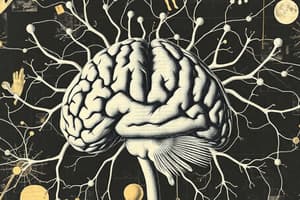Podcast
Questions and Answers
What are the three main parts of a neuron?
What are the three main parts of a neuron?
Soma (body), dendrites, and axon
What is the primary function of neurons in the nervous system?
What is the primary function of neurons in the nervous system?
Transmission of information and processing sensory inputs
What are the two broad categories of neurotransmitters and what do they do?
What are the two broad categories of neurotransmitters and what do they do?
Excitatory and inhibitory - Excitatory strengthens communication, inhibitory weakens it
What is the role of motor neurons?
What is the role of motor neurons?
How do sensory neurons differ from motor neurons?
How do sensory neurons differ from motor neurons?
Why are neurotransmitters important in neural communication?
Why are neurotransmitters important in neural communication?
Flashcards are hidden until you start studying
Study Notes
A neuron is a specialized cell within the nervous system responsible for sending electrical signals to other cells, known as action potentials. It consists of three main parts: the soma (body), dendrites, and axon. The soma contains most of the organelles and nucleus, while the dendrites bring input from other neurons into the soma. The axon transmits signals outwardly to target tissues. Neurons are connected via synapses with chemical messengers called neurotransmitters, which carry messages across these gaps between nerve cells.
The primary functions of neurons are transmission of information through the body's nervous system and processing sensory inputs, such as touch, sight, taste, smell, hearing, temperature, balance and more. There are several different types of neurons depending upon their shape and size; some have multiple branches, others are straight and some have many extensions. These classifications help determine how they communicate with each other throughout your body. For example, motor neurons control muscle movement whereas sensory neurons transmit pain sensation, heat or cold, light, sound or pressure to the brain.
Neurotransmitters serve as the means by which one neuron communicates its signal to another neuron. They come in two broad categories: excitatory type, which strengthens the communication, and inhibitory type, which weakens it. This allows for precise regulation of activity throughout the nervous systems and helps maintain stability despite changing conditions inside and outside our bodies.
In addition to these basic components, there are also neural networks formed when groups of neurons work together across vast distances. These interconnected structures allow us to process complex information very quickly so we can respond efficiently to changes in our environment. Overall, neurons are essential elements that make up our brains and nervous systems, allowing them to perform their critical functions effectively and rapidly.
Studying That Suits You
Use AI to generate personalized quizzes and flashcards to suit your learning preferences.




